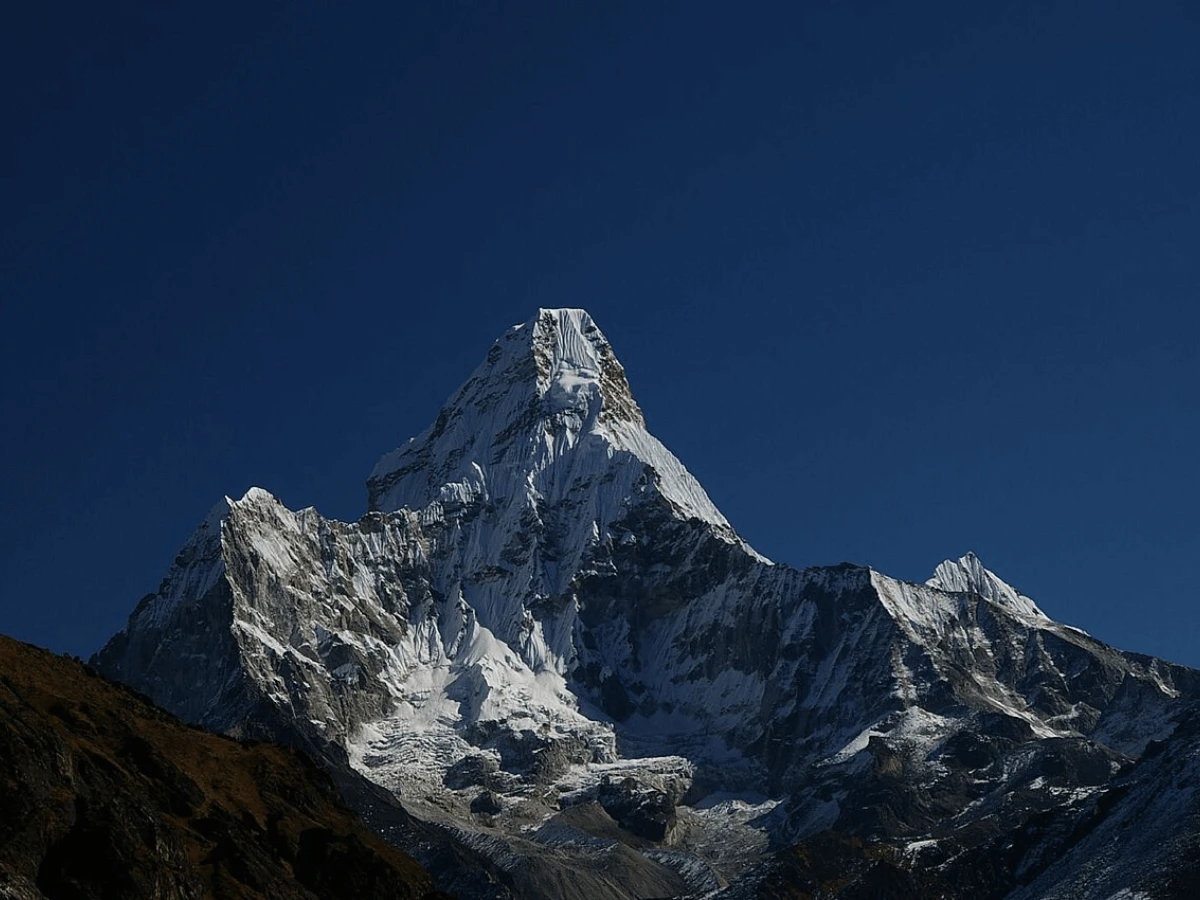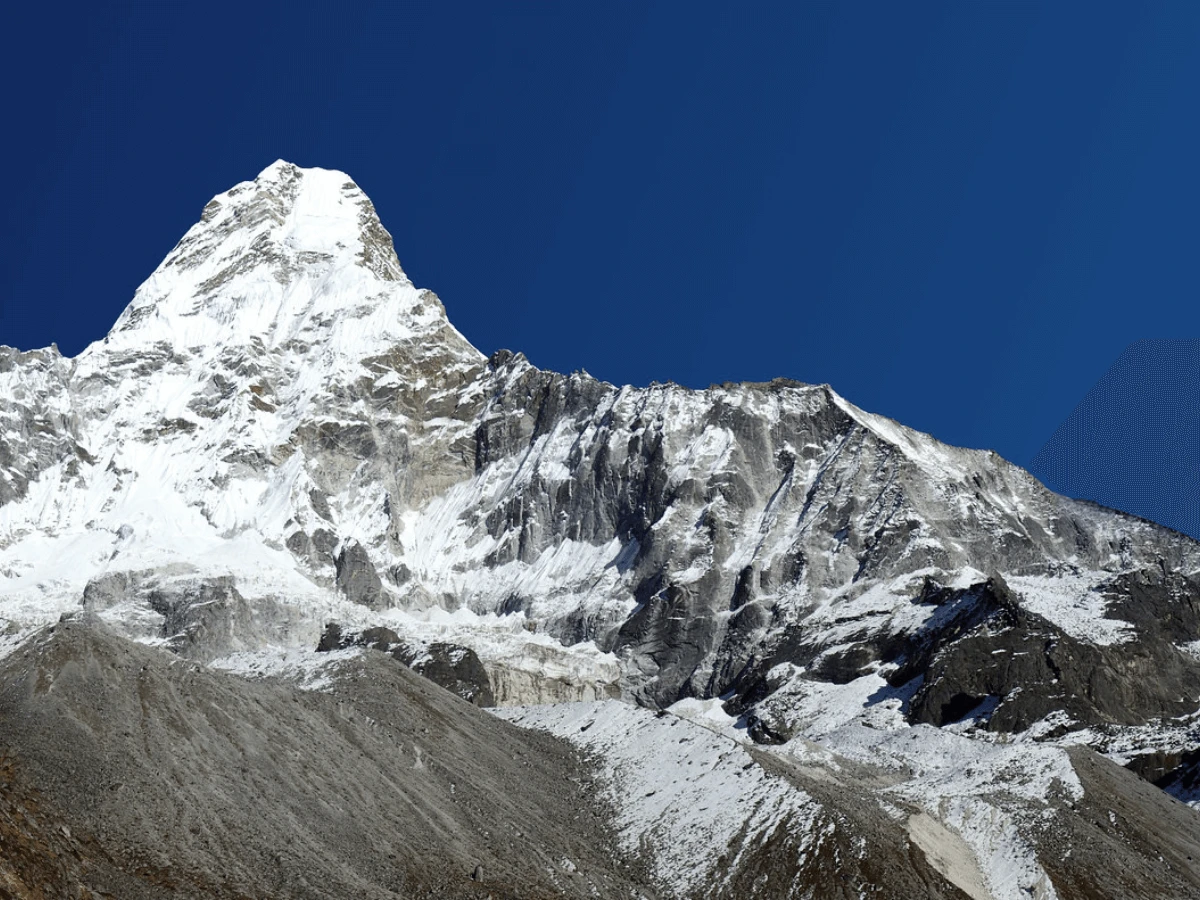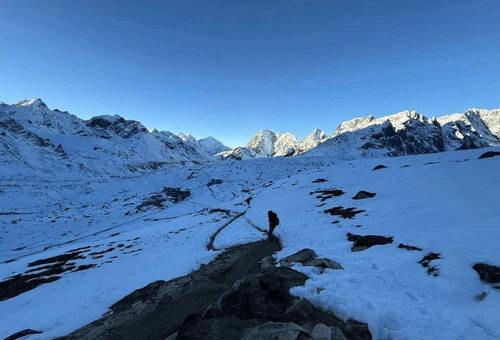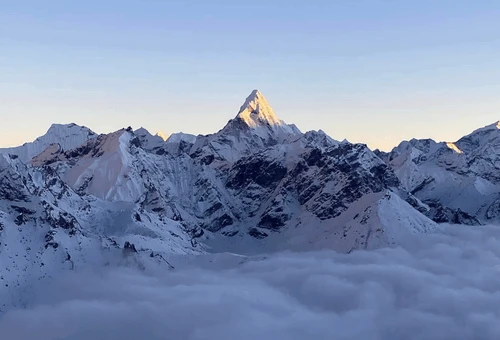The Ama Dablam Base Camp Trek is one of the less-explored trekking routes in the Everest Region. Ama Dablam (6,812m) is often called the “Matterhorn of the Himalayas.” Admire the stunning panoramas ofAma Dablam itself and neighbouring giants like Everest, Lhotse, and Nuptse from the Base Camp. The trip offers a mix of high-altitude scenery, Sherpa culture, and views of the gigantic 8000-meter peaks.
Following the route of the classic Everest Base Camp Trek 14 Days through rhododendron forests, Sherpa villages, and Buddhist monasteries. This 8-day journey from Kathmandu/Lukla up to Ama Dablam’s base camp at 4600 meters is challenging and rewarding as well. From Lukla, explore several villages like Phakding, Namche, Tengboche, Pangboche, and lastly hike to Ama Dablam Base Camp. Though it is an 8-Day Ama Dabam Base Camp Trek, trekkers must be physically fit and mentally tough to complete this trek.
Why the Ama Dablam Base Camp Trek Should Be on Your Bucket List
Embarking on the Ama Dablam Base Camp Trek reveals some of the world's highest peaks, including Mount Everest. Trekkers are treated to breathtaking views of not only the majestic Ama Dablam itself but also a host of other legendary peaks like Mount Everest, Lhotse, Nuptse, Pumori, Thamserku, Island Peak, Kongde Peak, Tawoche Peak, etc.
Beyond the awe-inspiring mountain vistas, the trek offers a rich immersion into the unique culture of the local Sherpa people. Experience the warmth of Sherpa hospitality through visits to traditional villages such as Namche Bazaar, Khumjung, Khunde, Phortse, and Pangboche.
Moreover, discover the diverse landscapes and protected biodiversity of Sagarmatha National Park, a UNESCO World Heritage Site. This park is home to rare and fascinating wildlife, including the elusive Red Pandas and the agile Himalayan Thar.
Reaching the base camp, situated at a significant altitude of approximately 4,600 meters (15,092 feet), and standing in the shadow of the magnificent Ama Dablam creates unforgettable memories and a deep connection with the grandeur of the Himalayas.
8-Day Ama Dablam Trek Itinerary
The 8-Day Ama Dablam Base Camp Trek begins with a 30-35 minute scenic flight from Kathmandu to Lukla. From Lukla, the trek officially starts and follows a well-maintained trail through the Sherpa villages such as Ghat and Phakding. The pathway then goes alongside the Dudh Koshi River valley, providing trekkers with their first impression beauty of the Khumbu region.
The trail then gradually ascends towards Namche Bazaar, a beautiful Sherpa Town, mostly used for acclimatisation. Along the way, trekkers pass through Monjo, the gateway to Sagarmatha National Park, where trekking permits are checked.
The ascent to Namche involves crossing several suspension bridges, often adorned with colourful prayer flags, which add to the cultural richness of the journey. From Namche Bazaar, the trail winds through less-trodden paths, leading to charming villages like Kyangjuma and Phortse. These sections of the trek offer stunning views of peaks like Thamserku, Kongde Ri, and Khumbila. The next day, from Namche to Pangboche, a village home to one of the oldest monasteries in the region. The village provides closer and more dramatic views of the iconic Ama Dablam.
The final part of the trek involves a rewarding ascent from Pangboche to Ama Dablam Base Camp. The path climbs through green pastures, where yaks can often be seen grazing peacefully, culminating in a breathtaking and sensational close-up view of the majestic Ama Dablam peak from its base camp.
Understanding the 8-Day Ama Dablam Base Camp Trek Difficulty
The Ama Dablam trek is moderate to challenging. You do reach a high altitude of 4600m at base camp. But the climbs are generally not as steep as on longer treks. Fitness-wise, you should be in good shape and have prior hiking experience. You’ll hike 5–7 hours per day on rocky paths with elevation gain, so training helps. Still, compared to the classic Everest Base Camp trek, Ama Dablam is easier: you gain less altitude and often descend soon after base camp.
Most days are steady uphill or downhill walks. The toughest part is the last day trip to base camp: a steep 3–4 hour ascent from Pangboche on a rugged trail. In short, if you’re an experienced trekker with good stamina, the Ama Dablam Base Camp trek is doable. Guides on our trek emphasise pacing and acclimatisation. In practice, hikers of average fitness succeed by taking it slow at high camps and enjoying the journey.
Can I combine the Ama Dablam Base Camp Trek with the EBC Trekking?
Yes, you can combine the Ama Dablam Base Camp Trek with the EBC Trekking. The route to Ama Dablam Base Camp initially follows the same classic Everest Base Camp Trek trail from Lukla, the trek's starting point, up to the village of Pangboche. For those who want to explore, both base camps can be seamlessly combined with the Everest Base Camp Trek 14 Days. After reaching Pangboche, instead of turning back, continue the trek via Dingboche, Lobuche, and to Gorakshep.
Imagine getting a closer view of iconic Ama Dablam from its Base Camp and also hiking to Everest Base Camp and Kala Patthar in a combined trip. Reaching Everest Base Camp is an achievement in itself, and 360-degree views of Everest, Lhotse, and Pumori from Kala Patthar are truly remarkable. So, why not combine EBC Trek with Ama Dablam? If you need more details regarding the combined trip, feel free to contact us via email or WhatsApp us at +9779849790153.
Ama Dablam Trek 8-Day Cost for 2026, 2027
The total Ama Dablam Trek 8 Day cost ranges from USD 1200 to USD 2,000 or more per person for a standard trek lasting between 8 to 12 days. This range in cost is influenced by several factors, including the specific trekking agency chosen, the level of service provided, the size of the trekking group, and whether the package includes flights and other amenities. Mountain Eco Trails offers this trek at a fair price with no hidden costs and matches the price with the service provided.
Why choose Mountain Eco Trails for the Ama Dablam Trek in Nepal
Choosing the right trekking company can make a huge difference in your experience. Mountain Eco Trails specialises in operating the trek in the Everest Region, including the Ama Dablam Base Camp Trek, providing a balance of safety, professionalism, and local expertise. Here are a few reasons to trek with Mountain Eco Trails:
- Experienced crew members and official team.
- Flexible and customised Langtang Trek Itinerary with personalised service.
- Complimentary Services like Duffel Bag, Trekking Poles, SIM Card, and an hour trekker's massage
- First Aid Kit with basic medication.
- Hassle-free last-minute booking and trip arrangements.
- Competitive and Fair price that matches the services and has no hidden costs.
- Special Discount for a group of trekkers of more than 5 Pax.
With Mountain Eco Trails, you trek with a trusted local company that prioritises your experience, safety, and the environment. We strive to turn your Ama Dablam journey into an incredible memory you’ll cherish for life.






